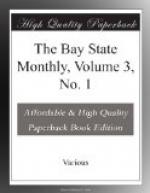The diplomatic correspondence which followed this high-handed outrage, like all the diplomatic (?) correspondence concerning Central America, while firm and bold on the part of this government, yet lacked that moral force, national importance, and perfect fearlessness, which the fetters imposed by the treaty prevented us from using or exhibiting.
With the treaty out of the way, and the principles of the “Monroe Doctrine” imprinted as a legend upon our banners, we should have stood on unassailable ground; have exhibited a national importance and vitality—an uncompromising firmness, courage and dignity that would have carried conviction, achieved immediate and honorable success, and commanded the respect of the civilized world. But fettered, tantalized, and weakened, by the ambiguities and inconsistencies of this co-partnership treaty, the United States government was compelled to temporize, argue, and explain, and finally compromise with her co-partner, and graciously allow the disgraceful fetters to remain.
Did Great Britain withdraw her protectorate? No. Did she withdraw her colonies from the Bay Islands? No. Did she give up her new geography of Central America, and restore Balize to its original territory? No. Did she yield a single point in the controversy, except to give up and repudiate as unauthorized the seizure of San Juan? No. Not in a single instance when the territory of Central America was at stake, and the provisions of the treaty were concerned, did she yield a single point; but she has even claimed and argued, that under the proper interpretation of the terms of that treaty she may hold all that she then enjoyed, and all that she can seize or buy, which is more than five statute miles from the coast line of any part of Central America; because, as she says, the treaty means the political, not the geographical Central America, and the political Central America is that part only of the continent which is contained within the limits of the five Central American republics; while the geographical Central America comprises all the territory and adjacent waters which lie between the republic of Mexico and South America; and that as Balize, Yucatan, and the Bay Islands, were not within the limits of the five Central American republics, they are no part of the Central America designated and intended in the treaty, and are not included in the term “other territory” used in said treaty.
The United States on the other hand claimed that the express language of the treaty, to wit: “that neither will occupy, or fortify, or colonize, or assume, or exercise any dominion over Nicaragua, Costa Rica, the Mosquito Coast, or any part of Central America,” means the geographical Central America, including all that is not specifically enumerated from Mexico on the north, to New Grenada or the United States of Columbia on the south; that the claim of Great Britain was not a tenable or reasonable one, and that the understanding was, that neither government should thereafterwards acquire, or assume any control over, any part of the territory lying between Mexico and South America.




